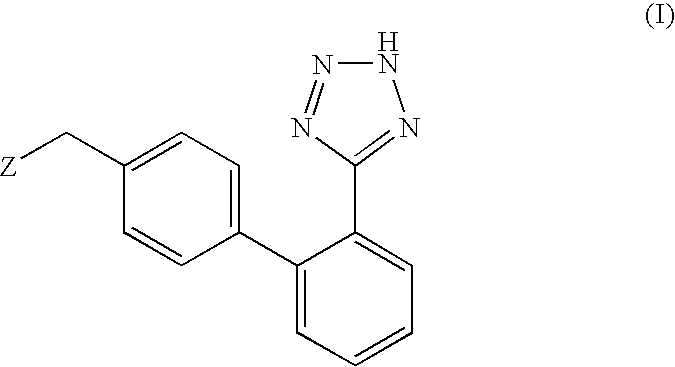Process for the preparation of angiotensin ii antagonistic compounds
a technology of angiotensin and antagonist, which is applied in the field of process for the preparation of angiotensin ii antagonists, can solve the problems of increased cost and longer tim
- Summary
- Abstract
- Description
- Claims
- Application Information
AI Technical Summary
Problems solved by technology
Method used
Image
Examples
example 1
Synthesis of (S)-2-(4-bromo-benzyl)-amino-3-methyl-butyric acid; (VI)
[0067] 45.0 g of sodium methoxide (30% w / w in methanol) are dropped into a suspension of 29.2 g of L-valine and 250 ml of methanol, under nitrogen. The mixture is left under stirring at room temperature to complete solution. The resulting clear solution is added with 47.1 g of p-bromobenzaldehyde and kept under stirring for 90 minutes. After that, 7.2 g of sodium boron hydride are added to the reaction mixture that is left under stirring for 1 hour, then concentrated under vacuum at a temperature of 40-50° C. to obtain a very concentrated but still stirrable mass (about 120-150 ml), which is added with 400 g of water. Methanol is distilled off under vacuum. The reaction mixture is then acidified to pH 2 with 37% HCl w / w, to precipitate the product, which is filtered with suction, washed with some water and dried under vacuum at 50° C. to obtain 70 g of dry product.
example 2
Synthesis of (S)-2-[(4-bromo-benzyl)-pentanoyl-amino]-3-methyl-butyric acid; (II)
[0068] A 1000 ml jacketed reactor, purged with nitrogen, is loaded with 70 g of (S)-2-(4-bromo-benzyl)-amino-3-methyl-butyric acid in 325 g of water and 108 g of triethylamine. The mixture is stirred at room temperature to completed solution, then cooled to −5° C. and dropwise added with 32 g of valeroyl chloride, keeping this temperature. When the addition is over, the mixture is left to stand for 30 min, then warmed to 15° C. and added with 180 ml of toluene. 60 ml of glacial acetic acid are then dropped into the stirred mixture to pH 5. Phases are separated, the lower one is discarded, and the other is added with 250 ml of water and 20 g of aqueous 50% w / w NaOH to pH 10. Phases are separated, the organic one is discarded, and the aqueous one is added first with 150 ml of heptane, then with 37% w / w HCl to pH 1. The resulting solid is left under stirring for 1 hour, then filtered with suction, and dri...
example 3
Synthesis of Valsartan
[0070] An aqueous solution (120 ml) of potassium hydroxide (0.568 mol, 31.8 g) is added in succession with 2-[(4-bromo-benzyl)-pentanoyl-amino]-3-methyl-butyric acid (0.811 mol, 30.0 g), tetrahydrofuran (120 ml), triphenylphosphine (0.0121 mol, 3,2 g) and palladium acetate (0.00405 mol, 0.91 g). The reaction mixture is refluxed and added with 2-(2H-tetrazol-5-yl)-benzene-boronic acid (0.142 mol, 27.0 g) in portions in about 6 h. After completion of the addition, the mixture is left to react for 2 h, then cooled to room temperature and the phases are separated. The organic phase is diluted with water (120 ml) and tetrahydrofuran is distilled off under reduced pressure. The remaining aqueous solution is acidified to pH 6.5 and washed with isopropyl acetate (60 ml). The aqueous phase is acidified to pH 2 and diluted with isopropyl acetate (60 ml), the diphasic solution is filtered to remove phenyltetrazol. Phases are separated and the organic phase is concentrate...
PUM
| Property | Measurement | Unit |
|---|---|---|
| Fraction | aaaaa | aaaaa |
| Molar ratio | aaaaa | aaaaa |
Abstract
Description
Claims
Application Information
 Login to View More
Login to View More - R&D
- Intellectual Property
- Life Sciences
- Materials
- Tech Scout
- Unparalleled Data Quality
- Higher Quality Content
- 60% Fewer Hallucinations
Browse by: Latest US Patents, China's latest patents, Technical Efficacy Thesaurus, Application Domain, Technology Topic, Popular Technical Reports.
© 2025 PatSnap. All rights reserved.Legal|Privacy policy|Modern Slavery Act Transparency Statement|Sitemap|About US| Contact US: help@patsnap.com



